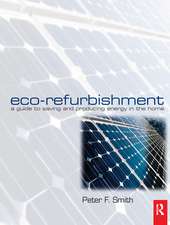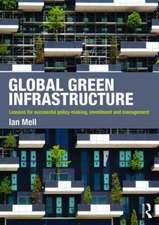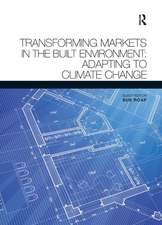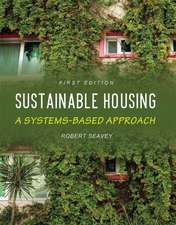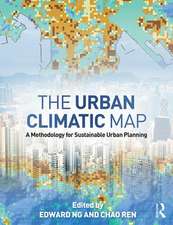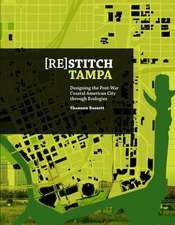The Passivhaus Handbook: A practical guide to constructing and retrofitting buildings for ultra-low energy performance: Sustainable Building
Autor Janet Cotterell, Adam Dadebyen Limba Engleză Paperback – 24 oct 2012
Preț: 212.63 lei
Preț vechi: 317.74 lei
-33% Nou
Puncte Express: 319
Preț estimativ în valută:
40.70€ • 44.22$ • 34.21£
40.70€ • 44.22$ • 34.21£
Carte disponibilă
Livrare economică 31 martie-14 aprilie
Preluare comenzi: 021 569.72.76
Specificații
ISBN-13: 9780857840196
ISBN-10: 0857840193
Pagini: 256
Ilustrații: Colour-design filled with photos and figures
Dimensiuni: 205 x 255 x 19 mm
Greutate: 0.92 kg
Editura: Bloomsbury Publishing
Colecția Green Books
Seria Sustainable Building
Locul publicării:London, United Kingdom
ISBN-10: 0857840193
Pagini: 256
Ilustrații: Colour-design filled with photos and figures
Dimensiuni: 205 x 255 x 19 mm
Greutate: 0.92 kg
Editura: Bloomsbury Publishing
Colecția Green Books
Seria Sustainable Building
Locul publicării:London, United Kingdom
Caracteristici
A practical guide to building a Passivhaus filled with advice on setting up and developing a project - a sustainable design that maximises energy efficiency, for those looking to create a comfortable, healthy and eco-friendly home.
Notă biografică
Janet Cotterell has wide experience of working in sensitive settings (conservation areas, listed buildings, historic parks), so is familiar with the use of traditional and natural materials. Her focus is on the importance of sustainable building practice and low-energy design principles. She is a chartered architect and a Certified Passivhaus Designer and holds an MSc in Architecture: Advanced Environmental & Energy Studies. Adam Dadeby is interested in different approaches to 'sustainability' and 'resilience' as they affect building practice. He is a Certified Passivhaus Consultant and member of the AECB (the Sustainable Building Association) and holds a postgraduate diploma in Architecture: Advanced Environmental & Energy Studies from the Centre for Alternative Technology (CAT).
Cuprins
Foreword by Wolfgang Feist IntroductionHow to use this book Part One: The how and why of PassivhausChapter 1: What is a Passivhaus?The Passivhaus energy standard, the Passivhaus concept, common misconceptions, retrofitting and the EnerPHit energy standardChapter 2: The economics of a PassivhausEconomic culture, energy costs and supplies, factors affecting property prices, factors affecting Passivhaus costs, methods of determining cost-effectivenessChapter 3: Passivhaus Certification Certification of buildings, building components, designers and contractors; the process and information required for building certificationChapter 4: Challenges of meeting the Passivhaus standard UK building culture, education and employment in construction, professional expertise, risk-aversity, the planning system, vernacular styles, the team approach, the disadvantages of a Passivhaus, Passivhaus and other low-energy standardsChapter 5: Natural materials, zero carbon and resilience Natural and low-embodied-energy building materials, zero carbon and the Code for Sustainable Homes (CSH), on-site low- or zero-carbon energy, post-peak energy, energy returned on energy invested (EROEI)Chapter 6: Setting up a Passivhaus project Choosing a plot, planning considerations, retrofit considerations, phased retrofitting and extensions, selecting an architect and builder, the role of the clientPart Two: Passivhaus projects: a practical guideChapter 7: Using the Passivhaus Planning Package (PHPP) History of the PHPP, PHPP worksheets: Verification, U-Values, Ground, WinType, Windows, Shading, Ventilation, Annual Heating Demand, Summer, Shading-S, DHW + Distribution, SolarDHW, ClimateChapter 8: Thermal bridges Constructional and geometrical thermal bridges, linear and point thermal bridges, thermal bypass, internal and external psi-values, dealing with thermal bridges, thermal bridge calculationChapter 9: Airtightness and sequencing Air leakage and Passivhaus, internal air quality (IAQ), airtightness standards, wind-tightness, breathable materials, airtight materials, air leakage at the design stage and construction stage, sequencing, on-site communication and training, airtightness testing, typical airtight construction detailsChapter 10: Moisture Liquid moisture and water vapour, relative humidity (RH) and indoor air quality (IAQ), capillarity, hygroscopicity, vapour permeability, moisture management in construction, breathability, example constructions (new build and retrofit)Chapter 11: Windows High-performance windows, U-values (frame, pane, spacer and installation factors), solar gain, window installation, window sills, doors, roof lights, avoiding summer overheating, the construction phase, future developments and costsChapter 12: Ventilation Ventilation in UK housing and in Passivhaus, indoor air quality (IAQ), humidity, mechanical ventilation with heat recovery (MVHR) (components, heating, efficiency, noise levels, possible objections to MVHR, installation skills)Chapter 13: Living in a Passivhaus Noise, energy bills, kitchen and bathrooom, drying clothes, the MVHR, entering and leaving the house, case studies (Totnes Passivhaus, Denby Dale, Grove Cottage, Passivhaus apartment buildings)Chapter 14: Policy change in the UK Planning, a building-fabric-based energy standard, floor measurement conventions, VAT, Energy Performance Certificates, property tax, change in the construction sector, self-build, home-grown Passivhaus products, culture and policy-makingAppendix A: Space heating and hot waterAppendix B: Thermal conductivity valuesAppendix C: US units - metric conversionsAppendix D: Certified Passivhaus projects in the UKGlossary of terms Glossary of units Notes Resources Index
Recenzii
As we move towards the 2016 zero carbon target in house building, Passivhaus construction looks like becoming not just popular in the UK, but commonplace. This is a no-nonsense and engaging introduction on how to do it.
This excellent book acts both as an introduction to the details of the Passivhaus methodology and how it works in practice. Anyone who has clients who have expressed interest in a Passivhaus project would be well advised to suggest they get a copy of the book, as it is extremely well written and accessible.
This book gives a wonderful overview of Passivhaus in the UK today, not only enabling interested parties to understand the principles and pitfalls for their own projects, but also for policy makers and planning officers to understand how to avoid some of their 'own goals' in attempting to encourage conservation.
The Passivhaus Handbook really is the 'bible' for developing passivhaus housing, particularly if you are thinking of a self-build passivhaus.
I'm delighted to see everything about Passivhaus and its application in the UK collated for the first tiime, in The Passivhaus Handbook. The first-hand experience of the authors provides an excellent grounding for the book.
This excellent book acts both as an introduction to the details of the Passivhaus methodology and how it works in practice. Anyone who has clients who have expressed interest in a Passivhaus project would be well advised to suggest they get a copy of the book, as it is extremely well written and accessible.
This book gives a wonderful overview of Passivhaus in the UK today, not only enabling interested parties to understand the principles and pitfalls for their own projects, but also for policy makers and planning officers to understand how to avoid some of their 'own goals' in attempting to encourage conservation.
The Passivhaus Handbook really is the 'bible' for developing passivhaus housing, particularly if you are thinking of a self-build passivhaus.
I'm delighted to see everything about Passivhaus and its application in the UK collated for the first tiime, in The Passivhaus Handbook. The first-hand experience of the authors provides an excellent grounding for the book.









